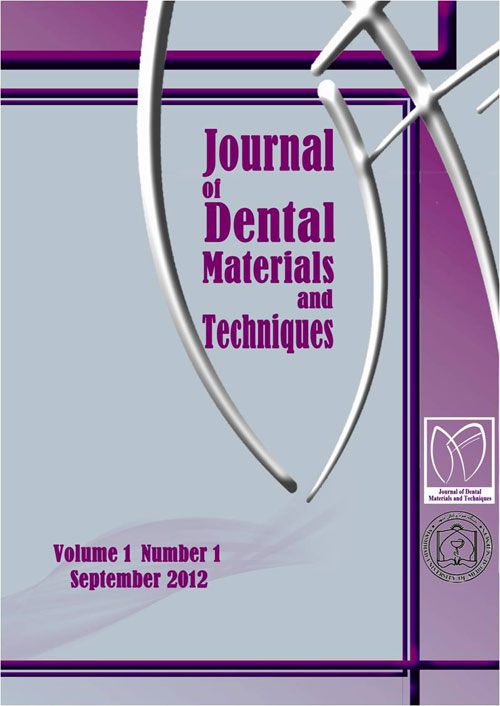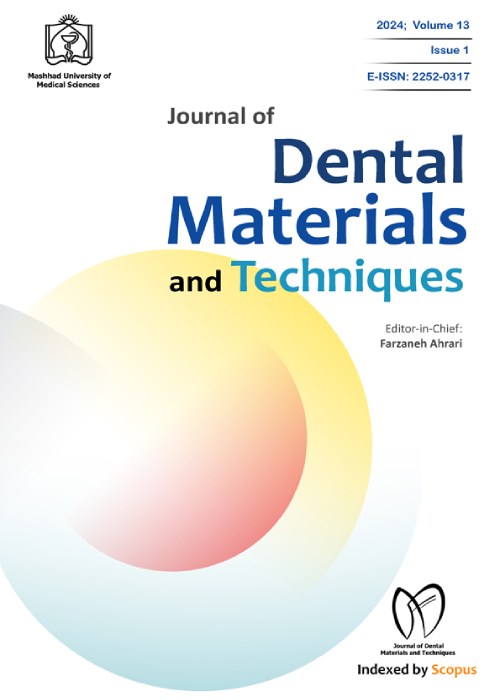فهرست مطالب

Journal of Dental Materials and Techniques
Volume:5 Issue: 4, Autumn 2016
- تاریخ انتشار: 1395/07/15
- تعداد عناوین: 8
-
-
Pages 162-171IntroductionResin composites are an important part of restorative treatment in modern dentistry. There are many trademarks available in Iran market and physico-chemical properties of many of these resin composites are not evaluated yet. This study was carried out to evaluate the physico-chemical properties of four available resin composites and also to assess the effect of aging on their properties. The findings of this study help clinicians to choose the best materials available.MethodsFour types of resin composites available in Iran market including Filtek Z350 XT, Filtek Z250, Herculite XRV Ultra and Herculite XRV were evaluated. Five samples were made of each composite using a metal mold (2* 10 * 10 mm). Two areas of each sample were light cured for 40 seconds. Samples were kept in saline for 24h and then underwent polishing process. Samples of each group were randomly allocated to five groups held in different conditions as follows: room temperature, distilled water in 37˚C, Distilled water plus hydrochloric acid, distilled water and thermocycling (5000 rounds of 5-55˚C), distilled water, thermocycling, and hydrochloric acid. At the end of one month, indentation was applied on each sample using nano-indentation technology (TriboIndenter, Hysitron, Minneapolis,MN).ResultsThe results of this study revealed that the type of composite and the environmental conditions affect elasticity and nano-hardness.Conclusionstorage conditions affected the elasticity of Filtek Z350XT, Herculite XRV Ultra and Herculite XRV and the hardness of Filtek Z350 XT and Herculite XRV Ultra.Keywords: resin composite aging, nanoindentation, nano, hardness, modulus of elasticity
-
Pages 172-180Background And AimIt is important to evaluate the effect of the type of filling material on deformation and strength of tooth after filling and also the effect of filling depth on quality of restoration of a decayed tooth.
Material andMethodsThe Orthopantomogram (OPG) of the first and second molars of a 28-year-old man was made and the teeth were 3D modeled. The stress-deformation analysis was then performed on the models in the three states of normal tooth, tooth filled with amalgam and tooth filled with composite using finite element method under a distributed load of 400N equivalent to chewing force. Two values (1/2 and 1/3 of the tooth height) were considered for filling depth in the analyses.ResultsThe results showed that the normal first molar was exposed to a 7.2% greater risk of dental injuries compared to the normal second molar and also a greater stress is created in it when it is filled with composite. The first molar filled with a composite material is 13.7% weaker than the normal tooth while it is almost as strong as a normal tooth when it is filled with amalgam. The effect of the type of filling material on the strength and deformation of the second molar was trivial.ConclusionAmalgam is a more proper dental filling material for the first molar although a 16.7% change in drilling depth is needed for tooth preparation. Dental filling material and filling depth have a small effect on the strength and deformation of filled second molars.Keywords: Amalgam, composite, tooth strength, filling depth, tooth deformation -
Pages 181-188Background And ObjectivesOne of the simplest and cheapest attachments for overdentures, is the ball-type attachment, however, keeping it during the first year of prosthesis delivery and after that is one of the main concerns of dentists. The present study aimed to assess the wear of matrix in overdentures attachment supported by one, two and three implants in the mandible.Materials And MethodsThirty edentulous patients were randomly divided into three groups: the first group received a single implant in the midline of the lower mandible, the second group two implants in areas B and D, and the third group three implants in areas B, C, and D. The attachment used in patients prosthetic with single and two implants was O-ball/ring attachment and for patients with three implants, the treatment plan was ball bar-supported attachments. After placing the new matrix implant for each patient and obtaining their consent, the matrix wear was measured with CMM (Coordinate Measuring Machine) device. To compare matrix wear after six months and one year, measurements were repeated. Data analysis, using ANOVA and multiple comparisons was down by Tukey Test. variance with repeated measures and Tukey test were used to compare the groups two-by-two. P.value less than 0.05 was set statistical significant. SPSS 16 software was used for data analysis.ResultsThe data obtained from the CMM device showed that the lowest mean matrix wear in the maximum single implant and maximum mean were in group two.ConclusionBoth time and the number of implants had a significant effect on the wear of the O-ring.Keywords: wear in attachment, implant, supported overdentures, mandible
-
Pages 189-195Resin- dentin interface hydrolysis is one of the greatest problems in restorative dentistry, Because of collagenolytic and proteolytic activity of dentin enzymes. The aim of this study was to compare the effect of CHX 2% and NaOCl 5% as rewetting agent on resin-dentin micro tensile bond strength.Methods45 extracted, human caries-free third molar teeth were collected. After exposing of superficial dentin, etching and rinsing of dentin were done. Specimens were divided into 3 equal groups. In group 1, after drying of dentin, CHX 2% was used as rewetting agent for 60 seconds. In group2, NaOCl 5% used as rewetting agent for 120 sec and in group 3 (control), blot dry technique with water was used for substrate. Adhesive system (SingleBond , 3M ESPE , USA) and composite build up (Filtek Z250 ,3M ESPE , USA)) were applied for all groups. After 6 month storage, μTBS measured for hourglass-shaped specimens. Specimens loaded for micro tensile bond strength until fracture occurred.ResultsMicro tensile bond strength of group 1 significantly was higher than other groups (52.67±6.862). There was no significant difference between group 2(18.59 ± 6.081) and group 3(28.84± 6.231). (P= 0.094).ConclusionCHX acts as matrix metalloproteinases inhibitor and by preventing dentin collagen degradation can preserve the bond strength after 6 months.Keywords: dentin, micro tensile bond strength, CHX, matrix metalloproteinases inhibitor
-
Pages 196-201IntroductionCurcumin is the active ingredient in the traditional herbal remedy and dietary spice turmeric (Curcuma longa). Curcumin has a surprisingly wide range of beneficial properties, including anti-inflammatory, antioxidant, chemopreventive and chemotherapeutic activity. on basis of recent studies; it has antifungal and antibacterial effects. The aim of this study was in-vitro evaluation of antifungal effect of curcumin on candida albicans and comparing it with nystatin.Methodsafter preparing curcumin powder, 3 laboratory methods were used to evaluate antifungal effect. The first method was cell count technique, used to evaluate the amount of candida albicans after time, in different concentrations of curcumin in Dimethyl sulfoxide (DMSO). The second was cup bioassay, in which inhibitory a zone of curcumin in DMSO was evaluated in sabouraud culture plates; and in third method, inhibitory zones of dried disks; which contained curcumin in DMSO were evaluated.Resultsthe result of all three methods showed that curcumin has antifungal effect and this effect increases in more concentrations.Conclusioncurcumin has apparent and dose dependent antifungal effect on candida albicans.Keywords: Curcumin, antifungal effect, candida albicans, dimethyl sulfoxide
-
Pages 202-207IntroductionAs a result of aging process, oral mucosa becomes susceptible to oral diseases. Having knowledge about prevalence and distribution of geriatric oral diseases is essential for prevention and treatment planning. This study aimed to evaluate the prevalence of geriatric patients oral biopsies in specimens obtained in medical centers of Zahedan University of Medical Sciences.MethodsThis cross-sectional study was conducted on 2496 cases of biopsied oral lesions found in pathology archive of medical centers of Zahedan University of Medical Sciences throughout a 20-year period. Information about age, gender, lesion location and type of oral lesions of patients over 60 years old were collected and analyzed using SPSS software.ResultsIn this cross-sectional study, 412 (16.5%) biopsy samples were taken from patients over 60 years old. Most subjects were in their seventh decade (59.5%), male (56.1%) and soft tissue (96.6%). Two hundred and sixty (63.1%) cases were neoplastic lesions and 152 (36.9%) were non-neoplastic. There was no significant relationship between the type of lesions (neoplastic and non-neoplastic) and age, gender and their location. The most prevalent lesions were oral squamous cell carcinoma (42.5%), non-specific inflammatory lesions (7.8%), irritation fibroma (3.4%) and oral verrucous carcinoma (3.4%).ConclusionSince the malignant lesions were the most common oral lesions in the studied geriatric patients, oral health care must be prioritized in the general health policies.Keywords: Elderly, Oral pathology, Epidemiologic study
-
Pages 208-212Adenoid cystic carcinoma (AdCC) is a malignant neoplasm, which accounts for 5-10% of all salivary gland tumors (1). About 50% of these tumors originate from intraoral minor salivary glands usually in the hard palate (1). Three clinically obvious characteristics of AdCC include slow growth rate, perineural invasion and high incidence of distant metastasis (1). The most commonly-affected sites of distant metastasis are bone, liver and brain, followed by lungs (2). Lymph node metastases are rare; The most common sites involved by hematogenous spread are lungs (2). This is a report about a patient with a rare form of AdCC on buccal mucosa with an unusual metastasis to the frontal region after a two-year follow up.Keywords: adenoid cystic carcinoma, buccal mucosa, frontal metastasis
-
Page 213The term odontoma is used to identify a tumor that is characterized by the production of mature enamel¡ dentin¡ cementum and pulp tissue and may interfere with the eruption of the associated tooth. The present report describes an odontoma in a 13-year-old boy¡ which is associated with an impacted tooth through a canal.Keywords: compound odontoma, mandible, odontogenic tumor, impacted tooth


